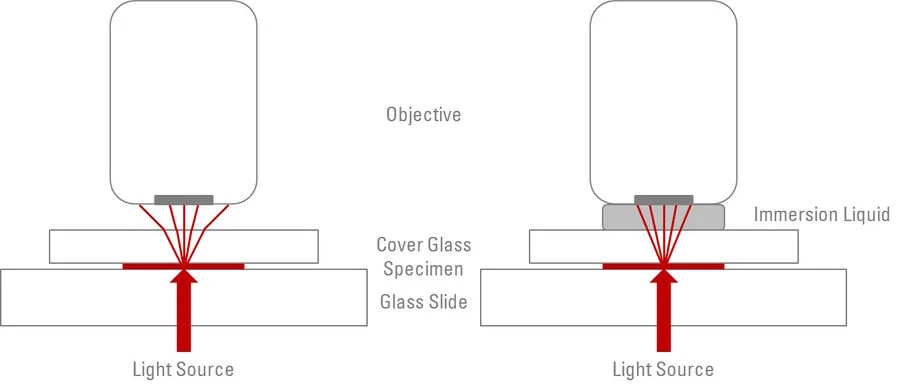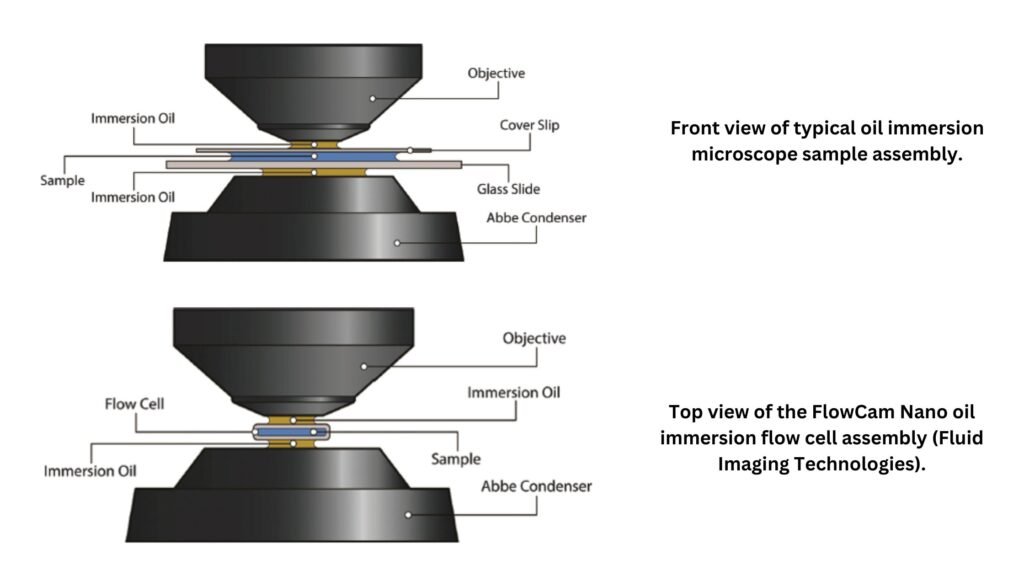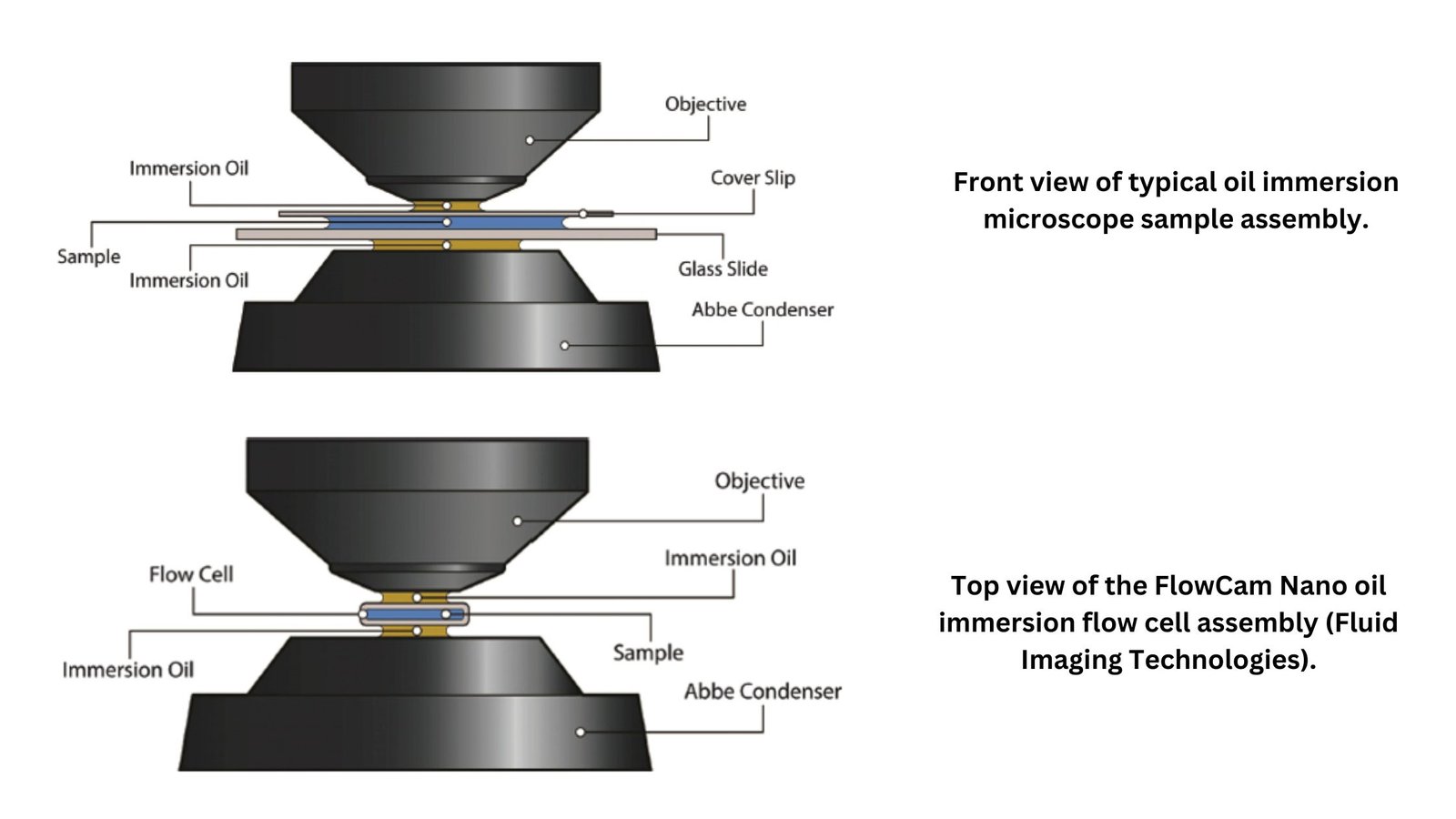The oil immersion technique is a method used in microbiology to increase the resolution of a microscope when examining specimens at high magnification. By applying a special oil (usually immersion oil) between the lens and the slide, it enhances the clarity of the image.
Why is oil necessary? It’s all about improving light transmission. Without it, light refracts as it passes through the air, distorting the view. Oil, however, has a similar refractive index to glass, ensuring light passes through smoothly.
The process involves placing a drop of oil directly onto the specimen, then carefully positioning the objective lens to immerse in the oil. This minimizes refraction, making the specimen appear clearer and more detailed under the microscope.
This technique is particularly useful for viewing specimens at higher magnifications (typically 100x), where the detail is most critical. Think of it like getting a clearer view through a foggy window—without oil, the specimen can appear blurry.
While the oil immersion technique is essential for high-quality viewing, it’s important to clean the lens and slide thoroughly after use. A small amount of oil left behind can damage lenses or cause the image to blur during future use.
The technique requires some finesse. Rushing can lead to air bubbles or improper positioning of the lens, both of which can ruin your observations.
In practice, the oil immersion technique is indispensable in fields like bacteriology and pathology. It’s the difference between seeing a general blur and identifying the intricate structures of cells or microorganisms.
So, when you look through the microscope and see that amazing, detailed image, thank the oil! It’s the unsung hero of high-resolution microscopy.

What is Oil Immersion?
Oil immersion is one of the techniques used in microscopy that highly improves the resolving power of a microscope by utilizing a transparent oil with a refractive index nearly equivalent to that of glass. It involves putting a drop of immersion oil between the objective lens and the specimen such that light will pass through with minimal refraction, which, in turn, increases the sharpness and definition of an image.
- Purpose – To increase the numerical aperture of the objective lens so that the resolving power of the microscope is improved.
- Application – Mostly used in high magnification microscopy, for example in observing the cellular fine structure or small microorganisms.
- Considerations – Suitable for those specimens that remain stationary and a few micrometers in thickness.
Why is Oil Immersion used?
Oil immersion is a technique used in light microscopy to enhance both image quality and resolution. The main reasons for oil immersion are:
- High Refractive Index – Oil immersion oils have a very high refractive index, around 1.515, close to that of glass. This reduces the amount of refraction happening in the light as it passes from the specimen through the cover slip and into the objective lens, allowing more to be captured.
- Reduced Air Gap– The immersion technique increases the numerical aperture (NA) of the lens system by substituting the air gap that is present between the objective lens and the cover glass with oil. An increased NA allows for the collection of much more light; hence, this provides enhanced resolution and clear images of very small structures. Improved Image Quality
- Brighter Images- The use of immersion oil results in brighter images than those taken without it. This is because more light is transmitted and the scattering effects are reduced when light travels through oil rather than air.
- Higher Contrast- In addition, oil immersion can greatly increase the contrast in images, making it easier to distinguish fine details in specimens, such as cellular structures or small organisms. Ideal for High Power.
- Suitable for Small Specimens- Oil immersion is particularly advantageous when examining small specimens measuring 1 to 2 micrometers in size or less, and when using high magnification objectives often over 100x. This means a much finer view of structures such as bacteria or cellular organelles that could easily be missed at lower magnifications.
Objectives of Oil Immersion Technique
- Better Resolution – The oil immersion method makes the resolution of the microscope better because the bending of light is reduced. This creates clearer and sharper pictures.
- More Light Gathering – The objective lens captures more light when using immersion oil, making the image brighter and clearer.
- Higher Magnification– It allows clear viewing at higher magnifications, usually 100x, which would otherwise make images blurry without the oil.
- Better Contrast – This technique makes the image clearer, showing more of the small details of the specimen.
- Reduced Light Scattering – the oil ensures that only the maximum available light is forwarded to the objective lens, thereby producing a better-illuminated image and reduced scattering of light.

Immersion oil Types
- Synthetic Oil– is a type of oil that is made from cleaned petroleum products. It has high clarity and little optical distortion. It is used in advanced microscopy.
- Natural Oil – For instance, these are plant-derived oils, such as cedarwood or clove. They were natural products consumed by people, but they are not as frequently applied currently because of the existence of artificial products.
- Cedarwood Oil is a natural oil with a high refractive index. It is sometimes used in labs for special optical needs.
- Type A Oil is an immersion oil with a refractive index approaching to about 1.515, which makes it highly suited for general laboratory work using 100x objective lenses.
- Type B Oil – Higher-grade immersion oil that has a refractive index close to 1.518; it is intended for more specific high power microscopes and therefore gives clearer pictures.
Immersion oil Technique Procedure
- Prepare the slide by gently placing the specimen on the glass surface. Don’t forget to add a drop of immersion oil directly atop the specimen.
- Use the 100x objective lens or the oil immersion lens. Take extreme care in rotating the objective lens to avoid breaking the slide.
- Now lower the objective lens very gently and keep it suspended immediately above the surface of the slide, so that it just touches the slide surface. Oil will then make an ideal optical path between the specimen and the lens.
- Now, once the lens is held firmly in place, rotate the fine focus knob gently to bring the image into focus. The immersion oil will offer a more precise, high magnification view of the specimen.
- Adjust the light; sometimes you have to change the intensity on the microscope, especially when using oil immersion, as it may require extra illumination.
- After use, the objective lens should also be cleaned gently using lens paper and an appropriate cleaning solution to remove the remainder of the oil. If it is not intended to be reused, then it should be cleaned as well.
Advantages of Immersion oil Technique
- Increased Resolution – Immersion oil has a higher refractive index than air. That means it collects more light and, thus, provides a sharper, clearer image. That adds to resolution.
- Higher Magnification– It works very well with specimens viewed at higher magnifications, especially at 100x objectives that can reveal more details.
- Improved Light Transmission – The use of immersion oil reduces the loss of light due to refraction, thus making the image brighter and more contrasted.
- Improved Contrast of the Image– The oil has special optical properties that make the minute details of transparent specimens visible.
- Reduced Aberrations– The oil reduces optical aberrations such as spherical and chromatic distortion, thus making the image more precise.
- More Accurate Viewing – For some samples, immersion oil ensures that light travels straight between the objective lens and the sample for a much clearer image.
- Wider Field of View – The oil captures extra light for an improved total field of view as compared to dry objectives.
Limitations of Immersion oil Technique
- Messy Cleanup– Immersion oil used in a lens or slide has to be cleaned off very carefully; otherwise, streaks may form, leaving residues or even damaging the optics.
- Special Maintenance Needed – Continuous usage of immersion oil wears off the lenses when not maintained correctly. Lenses need to be cleaned regularly to prevent the buildup of oils.
- Limited to High Magnification– It is used mainly at high magnifications, which are mostly at 100x, and is not so effective in tasks where low or medium magnification is needed.
- Risk of contamination– If not handled appropriately, the oil contaminates either the sample or the lens and may interfere with the clarity of the image.
- Expensive- The oil itself does not bear a price tag, but frequent use of the oil in the laboratory may incur money in the form of products for maintenance and cleaning.
- Interference of Oil with Specimens- Sensitive or even living specimens may not be suitable for immersing in immersion oil as it would alter the appearance of the specimen or damage the sample.
- Limited Depth of Field – At very high magnifications, even with immersion oil, the depth of field is pretty shallow, so focusing is somewhat of a task.
